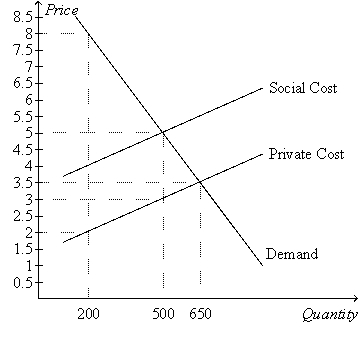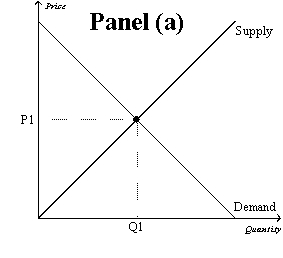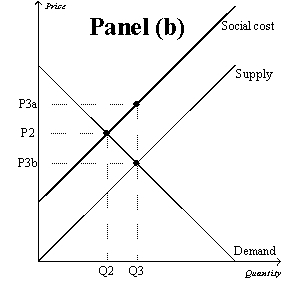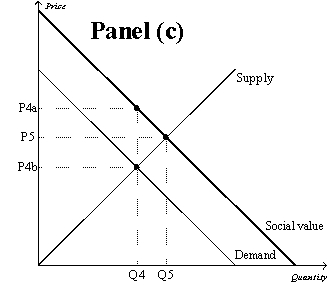A) They are equal.
B) The equilibrium quantity is greater than the socially optimal quantity.
C) The equilibrium quantity is less than the socially optimal quantity.
D) There is not enough information to answer the question.
F) A) and B)
Correct Answer

verified
Correct Answer
verified
Multiple Choice
According to the Coase theorem,in the presence of externalities
A) private parties can bargain to reach an efficient outcome.
B) government assistance is necessary to reach an efficient outcome.
C) the assignment of legal rights can prevent externalities.
D) the initial distribution of property rights will determine the efficient outcome.
F) B) and D)
Correct Answer

verified
Correct Answer
verified
Multiple Choice
Figure 10-2.The graph depicts the market for plastic.  -Refer to Figure 10-2.Suppose that the production of plastic creates a social cost which is depicted in the graph above.What is the socially optimal quantity of plastic?
-Refer to Figure 10-2.Suppose that the production of plastic creates a social cost which is depicted in the graph above.What is the socially optimal quantity of plastic?
A) 200 units
B) 450 units
C) 500 units
D) 650 units
F) A) and B)
Correct Answer

verified
Correct Answer
verified
Multiple Choice
Figure 10-9 

 -Refer to Figure 10-9,Panel (b) and Panel (c) .The overuse of antibiotics leads to the development of antibiotic-resistant diseases.Therefore,the socially optimal quantity of antibiotics is represented by point
-Refer to Figure 10-9,Panel (b) and Panel (c) .The overuse of antibiotics leads to the development of antibiotic-resistant diseases.Therefore,the socially optimal quantity of antibiotics is represented by point
A) Q2.
B) Q3.
C) Q4.
D) Q5.
F) B) and D)
Correct Answer

verified
Correct Answer
verified
Short Answer
At any given quantity,the willingness to pay of the marginal buyer is the height of the __________.
Correct Answer

verified
Correct Answer
verified
Multiple Choice
Patents do not
A) provide firms an incentive to research.
B) assign property rights to inventors.
C) protect the rights of inventors for their lifetimes.
D) internalize externalities.
F) A) and D)
Correct Answer

verified
Correct Answer
verified
True/False
Corrective taxes enhance efficiency,but the cost to administer them exceeds the revenue they raise for the government.
B) False
Correct Answer

verified
Correct Answer
verified
Multiple Choice
Corrective taxes are unlike most other taxes because they
A) distort incentives.
B) move the allocation of resources away from the social optimum.
C) raise revenue for the government.
D) move the allocation of resources closer to the social optimum.
F) A) and D)
Correct Answer

verified
Correct Answer
verified
Multiple Choice
Two types of private solutions to the problem of externalities are
A) charities and the Golden Rule.
B) charities and subsidies.
C) the Golden Rule and taxes.
D) taxes and subsidies.
F) A) and C)
Correct Answer

verified
Correct Answer
verified
Multiple Choice
Since externalities tend to keep markets from reaching a socially optimal equilibrium,government action
A) is always needed because private solutions can never be attained.
B) is needed when private solutions fail to arise.
C) will be needed only to correct for positive externalities.
D) will be needed only to correct for negative externalities.
F) A) and B)
Correct Answer

verified
Correct Answer
verified
Multiple Choice
The Coase theorem asserts that the private market will always solve the problem of externalities and allocate resources efficiently
A) even if private parties experience substantial costs of bargaining.
B) even if the initial distribution of legal rights is skewed in favor of some private parties over others.
C) only when there is a large number of private parties that engage in bargaining.
D) All of the above are correct.
F) A) and D)
Correct Answer

verified
Correct Answer
verified
Multiple Choice
When externalities exist,buyers and sellers
A) neglect the external effects of their actions,but the market equilibrium is still efficient.
B) do not neglect the external effects of their actions,and the market equilibrium is efficient.
C) neglect the external effects of their actions,and the market equilibrium is not efficient.
D) do not neglect the external effects of their actions,and the market equilibrium is not efficient.
F) None of the above
Correct Answer

verified
Correct Answer
verified
Multiple Choice
Research into new technologies provides a
A) negative externality,and too few resources are devoted to research as a result.
B) negative externality,and too many resources are devoted to research as a result.
C) positive externality,and too few resources are devoted to research as a result.
D) positive externality,and too many resources are devoted to research as a result.
F) B) and C)
Correct Answer

verified
Correct Answer
verified
Multiple Choice
Externalities tend to cause markets to be
A) inefficient.
B) unequal.
C) unnecessary.
D) overwhelmed.
F) B) and C)
Correct Answer

verified
Correct Answer
verified
Multiple Choice
What economic argument suggests that if transactions costs are sufficiently low,the equilibrium is economically efficient regardless of how property rights are distributed?
A) the Coase theorem
B) the laws of supply and demand
C) the law of comparative advantage
D) the law of externalities
F) A) and B)
Correct Answer

verified
Correct Answer
verified
Multiple Choice
Since air pollution creates a negative externality,
A) social welfare will be enhanced when some,but not all air pollution is eliminated.
B) social welfare is optimal when all air pollution is eliminated.
C) governments should encourage private firms to consider only private costs.
D) the free market result maximizes social welfare.
F) B) and D)
Correct Answer

verified
Correct Answer
verified
Multiple Choice
Table 10-1
The following table shows the private value,private cost,and external cost for various quantities of output in a market.
 -Refer to Table 10-1.What is the equilibrium quantity of output in the market?
-Refer to Table 10-1.What is the equilibrium quantity of output in the market?
A) 2 units
B) 3 units
C) 4 units
D) 5 units
F) A) and D)
Correct Answer

verified
Correct Answer
verified
Multiple Choice
Which of the following is true of markets characterized by positive externalities?
A) Social value exceeds private value,and market quantity exceeds the socially optimal quantity.
B) Social value is less than private value,and market quantity exceeds the socially optimal quantity.
C) Social value exceeds private value,and market quantity is less than the socially optimal quantity.
D) Social value seldom exceeds private value;therefore,social quantity is less than private quantity.
F) A) and C)
Correct Answer

verified
Correct Answer
verified
Multiple Choice
Dog owners do not bear the full cost of the noise their barking dogs create and often take too few precautions to prevent their dogs from barking.Local governments address this problem by
A) making it illegal to "disturb the peace."
B) having a well-funded animal control department.
C) subsidizing local animal shelters.
D) encouraging people to adopt cats.
F) B) and D)
Correct Answer

verified
Correct Answer
verified
Multiple Choice
When a market is characterized by an externality,the government
A) can correct the market failure only in the case of positive externalities.
B) can correct the market failure only in the case of negative externalities.
C) can correct the market failure in the case of both positive and negative externalities by inducing market participants to internalize the externality.
D) cannot correct for externalities due to the existence of patents.
F) B) and C)
Correct Answer

verified
Correct Answer
verified
Showing 81 - 100 of 473
Related Exams